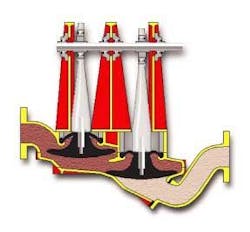The suction disc (right) is lifted from its seat creating a vacuum. The cavity between the discs is filled during the reciprocating motion of the suction disc. The discharge disc (left) is seated, creating a seal in the flow path during the suction cycle. The reciprocating action then causes the suction disc to seat and create a seal in the flow path and a downward motion of the discharge disc forces the discharge.
Click here to enlarge imageThe free-diaphragm technology uses a unique principle of operation whereby the discs perform the duties of both diaphragm and valve, providing a double acting, non-clogging, pumping action. Through an arrangement of connecting rods and camshafts, a reciprocating action of the discs is created, forming a large cavity between discs. This cavity is filled and exhausted on a continuous basis.
The valve-like discs mean that large solids and rags can be handled without loss of pumping action. The discs have large seating areas that provide for low internal velocities, extending the pump wear life on abrasive sludges and slurries.
The fluid chamber is sealed with flexible trunnions that eliminate packing, mechanical seals, and require no flushing water or other forms of lubrication. The design eliminates the close tolerances within the pumping chamber allowing the unit to run dry indefinitely without damage.
The pump requires no routine maintenance under normal operating conditions. There are no packing glands to adjust or mechanical seals to replace and all bearings are sealed for life and do not require re-lubrication. The only normal replacement items are two discs and two trunnions. The drive shaft, bearings and connecting rods are easily accessible.
The Double Disc pump is typically used in a variety of sludge and slurry handling applications to include belt press feed, centrifuge feed, thickened sludge transfer, primary sludge, scum, septage, lime slurry, etc.
Case Study
In November 2000 the Double Disc pump was chosen by the Ewing-Lawrence Sewage Authority in New Jersey to replace several rotary lobe pumps on their sludge transfer and belt press feed applications. The close tolerance design of the rotary lobe pump led to frequent breakages, worn lobes and seal failures given the debris and grit found in typical wastewater treatment plant sludge pumping applications.
The plant needed a pump to handle this debris without the headache. The authority evaluated several technologies, which included plunger, progressive cavity and double disc. Tony Ramsey, Plant Maintenance Supervisor, checked several references and visited a nearby installation using the Double Disc pumps.
Staff chose the design based on its simplicity, low to non-existent maintenance requirements, low spare parts replacement costs and the company's policy of keeping all replacement parts in stock 24-hours per day 7-days per week.
The pumps were installed in December 2001 and to date have not experienced a single failure or required any maintenance.



